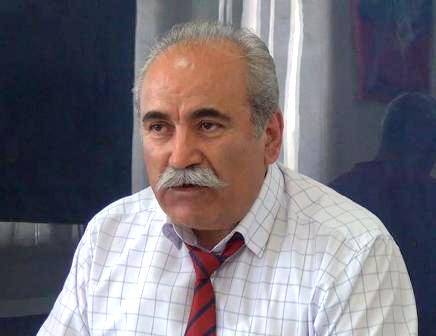 Parnag Shishigyan is a heroic Zeytountsi who retrieved hundreds of Armenian orphans from Arab families in the Syrian desert after the Armenian Genocide. His name is not known to most Armenians. Therefore it is worthwhile to focus attention on his life and his good deeds. He is buried in the little town of Hovdashad, a few miles outside of Yerevan.
Parnag Shishigyan is a heroic Zeytountsi who retrieved hundreds of Armenian orphans from Arab families in the Syrian desert after the Armenian Genocide. His name is not known to most Armenians. Therefore it is worthwhile to focus attention on his life and his good deeds. He is buried in the little town of Hovdashad, a few miles outside of Yerevan.
Last month, Zarmik Sargsyan from Yerevan posted on her Facebook page a very moving tribute to Parnag Shishigyan after visiting his grave. The only reference to his unique accomplishment is a booklet published 30 years ago by Hagop Jghlyan whose family he had rescued. The book was aptly titled, “A Life Left in the
Shadows.” Sargsyan attempted to take Shishigyan’s life out of the shadows and present him to the public at large.

From April 10 to May 18, 1915, the heroic town of Zeytoun in Cilicia was depopulated. The men were herded into the infamous Ottoman Turkish “Labor Battalions.” On the road to Deir Zor, Syria, 14-year-old Parnag, ignoring the snakes and scorpions around him, spent days cuddling the corpse of his mother who was killed by the sword of a Turkish soldier. He was rescued by a Bedouin Arab from the Shammar tribe, who, after digging a grave in the sand for Parnag’s mother with his dagger, placed the young boy on his horse and took him to his home.
Young Parnag who already knew Armenian, German and Turkish, soon also learned Arabic. Besides herding sheep and camels, Parnag, renamed Ahmet El Jezza, taught the tribesmen how to write in Arabic. He became very popular in the region because of his diligence, humility, and serious demeanor.
Soon, in the course of herding sheep, Parnag came across in the desert many Armenian children adopted by local Arabs. He reminded them of their Armenian heritage and began to write down their names and places of residence in a notebook.
In 1924, 23-year-old “Ahmet”, as a trusted and literate young man, was asked to deliver a herd of sheep bought by wealthy Arabs from Aleppo. Once in Aleppo, he was surprised to see Armenian signs on store fronts and people speaking in Armenian. He was offered a job and a place to stay by local Armenians, but he turned down the offers, saying he had a family in the desert and could not abandon them. He then showed to an Armenian shoemaker his notebook listing the names and places of Armenian children living in the desert with Arab families. He had promised himself to gather these Armenian children, help them marry each other and find their relatives, if still alive. It was a very difficult task. Most of the children, having lived with Arab families for several years, did not remember their heritage and did not know that there were other Armenians still in existence. But Parnag persisted despite the obstacles.
The shoemaker Panos, President of the Rescue Committee of Armenian orphans from Arab and Kurdish tribes, was stunned. During the last few months, the Committee had barely rescued a couple of children, and now Panos was seeing an entire notebook full of Armenian names.
After returning to his tribe, Parnag kept sending list after list of Armenian children to Aleppo. The Rescue Committee would then go to the desert, pay off the tribesmen and take the Armenian children to Aleppo or Beirut.
Eventually, the Syrian government allocated two villages in the desert to Armenians. Parnag got married to an Armenian woman by the name of Wadha who later changed her name to Siranoush. Respecting their adoptive Arab parents, they agreed to have the marriage ceremony performed by a Muslim Sheikh. The couple planned to have an Armenian wedding later on. Parnag’s four Arab “brothers” were not happy that he was leaving them to go and settle in the new Armenian village of Tel El-Brak. They divided the family belongings into five. Parnag took with him 100 sheep, five camels, a horse, a rifle, and household items.
Parnag brought the hundreds of Arabized Armenians to his village, gave them Armenian names and arranged their marriages. He organized the young men of the village to collect the bones of Armenian martyrs from Deir Zor, Raqqa, around the Euphrates and Khabour rivers and the tragic cave of Sheddedeh. Parnag held a memorial ceremony for the souls of the deceased!
The two Armenian villages in the desert soon prospered. They formed a sports organization and a music band. In 1947, when Parnag became aware of the mass migration back to Soviet Armenia he decided to return to the homeland! He left all his possessions behind except for one thing, his Arabian horse, which he donated to a horse ranch after arriving in Armenia.
Parnag’s family settled in Hovdashad, a village near Echmiadzin where he worked as a farmer. His wife, Siranoush, had five more children in Armenia. Even though Parnag had retrieved hundreds of Armenian children, he always thought of the hundreds of other children who were not, including his wife, Siranoush’s sister.
In the Hovdashad cemetery, there is a statue of Parnag in Arabic attire. The house that Parnag built in 1956 in that village is now like a museum, where his clothes and his photos are displayed.
Armenians both in Armenia and the Diaspora should visit the village of Hovdashad and Parnag’s grave to pay tribute to the man who retrieved hundreds of Armenian orphans and returned them to their heritage.
By Harut Sassounian
Publisher, The California Courier







